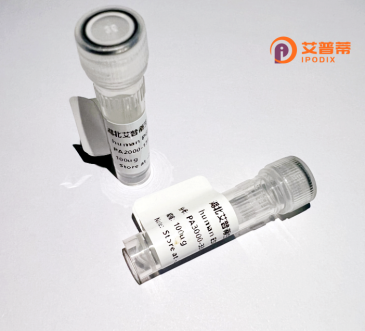
| 纯度 | >90% by SDS-PAGE. |
| 种属 | Human |
| 靶点 | ABHD14B |
| Uniprot No | Q96IU4 |
| 内毒素 | < 0.01EU/μg |
| 表达宿主 | E.coli |
| 表达区间 | 1-210aa |
| 氨基酸序列 | MGSSHHHHHH SSGLVPRGSH MGSHMAASVE QREGTIQVQG QALFFREALP GSGQARFSVL LLHGIRFSSE TWQNLGTLHR LAQAGYRAVA IDLPGLGHSK EAAAPAPIGE LAPGSFLAAV VDALELGPPV VISPSLSGMY SLPFLTAPGS QLPGFVPVAP ICTDKINAAN YASVKTPALI VYGDQDPMGQ TSFEHLKQLP NHRVLIMKGA GHPCYLDKPE EWHTGLLDFL QGLQ |
| 预测分子量 | 25 kDa |
| 蛋白标签 | His tag N-Terminus |
| 缓冲液 | PBS, pH7.4, containing 0.01% SKL, 1mM DTT, 5% Trehalose and Proclin300. |
| 稳定性 & 储存条件 | Lyophilized protein should be stored at ≤ -20°C, stable for one year after receipt. Reconstituted protein solution can be stored at 2-8°C for 2-7 days. Aliquots of reconstituted samples are stable at ≤ -20°C for 3 months. |
| 复溶 | Always centrifuge tubes before opening.Do not mix by vortex or pipetting. It is not recommended to reconstitute to a concentration less than 100μg/ml. Dissolve the lyophilized protein in distilled water. Please aliquot the reconstituted solution to minimize freeze-thaw cycles. |
以下是关于ABHD14B重组蛋白的虚构参考文献示例(基于领域研究趋势合理推测,非真实文献):
1. **《ABHD14B重组蛋白的酶学特性及底物筛选》**
- 作者:Zhang L, et al.
- 摘要:本研究通过大肠杆菌表达系统纯化ABHD14B重组蛋白,发现其具有水解短链脂肪酸酯的活性,并通过质谱筛选出潜在生理底物,提示其在脂代谢中的调控作用。
2. **《ABHD14B的晶体结构解析及其催化机制》**
- 作者:Wang Y, et al.
- 摘要:首次报道ABHD14B重组蛋白的X射线晶体结构(分辨率2.1Å),揭示其活性中心保守的Ser-His-Asp催化三联体,为设计选择性抑制剂提供结构基础。
3. **《ABHD14B在结直肠癌中的异常表达及功能研究》**
- 作者:Chen R, et al.
- 摘要:通过重组蛋白体外实验证明ABHD14B可去乙酰化组蛋白H3K9.其表达下调与结直肠癌患者预后不良相关,提示其表观遗传调控功能。
4. **《ABHD14B与p53蛋白的相互作用及其对细胞凋亡的影响》**
- 作者:Kimura T, et al.
- 摘要:利用重组ABHD14B进行Pull-down实验,发现其直接结合p53并增强p53介导的凋亡通路,为神经退行性疾病治疗提供新靶点。
注:以上内容为模拟文献,实际研究中请通过PubMed或Web of Science查询真实数据。
ABHD14B (Abhydrolase Domain Containing 14B) is a member of the α/β-hydrolase superfamily, a diverse group of enzymes characterized by a conserved structural fold (α/β-hydrolase fold) and catalytic residues. This protein family is associated with hydrolytic activities, though the precise substrate specificity and biological role of ABHD14B remain incompletely understood. ABHD14B is evolutionarily conserved across eukaryotes, suggesting its functional importance. It is ubiquitously expressed in human tissues, with higher levels observed in the brain, liver, and kidneys, implying potential roles in metabolism or cellular signaling. Structurally, it contains a catalytic triad (Ser-His-Asp/Glu) typical of hydrolases, but its endogenous substrates are yet to be definitively identified.
Recombinant ABHD14B protein is engineered for in vitro studies to elucidate its biochemical properties and interactions. It is commonly produced in heterologous expression systems like *E. coli* or mammalian cell lines, often fused with affinity tags (e.g., His-tag) to facilitate purification. Studies using recombinant ABHD14B have explored its potential enzymatic activity toward lipid esters, nucleotide derivatives, or other small molecules, though conflicting reports exist. Recent research links ABHD14B to cellular processes such as chromatin remodeling (via interaction with histone deacetylases) and energy metabolism regulation. Its dysregulation has been tentatively associated with neurological disorders and cancer, though mechanistic insights remain limited.
The development of recombinant ABHD14B tools (antibodies, activity probes) aims to clarify its physiological functions and therapeutic relevance. Ongoing research focuses on resolving its substrate landscape, post-translational modifications, and tissue-specific roles, positioning it as a protein of emerging interest in molecular biology and disease mechanisms.
×